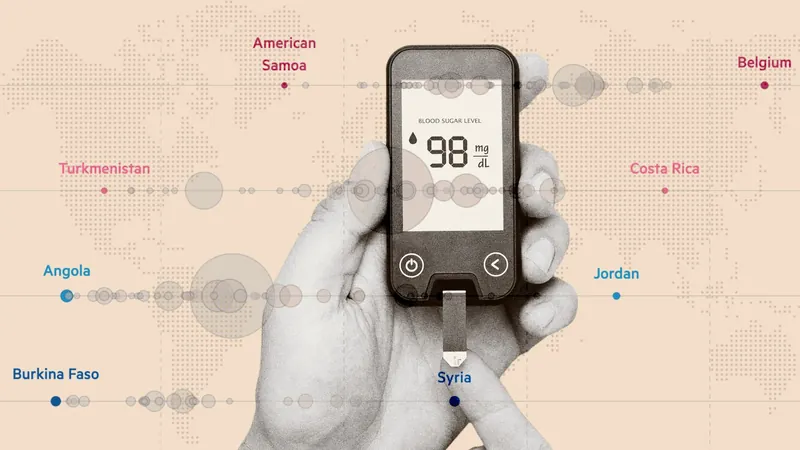
Shocking Study Reveals Three-Quarters of U.S. Adults Are Overweight or Obese – What It Means for Our Health!
2024-11-15
Author: Ting
Introduction
A new and alarming study has found that nearly three-quarters of adults in the United States are now classified as overweight or obese, highlighting a serious public health crisis. Published recently in The Lancet, this extensive research reveals an unprecedented rise in obesity rates across the nation since 1990, when just over half of adults fell into these categories. This growing epidemic poses substantial risks for individuals' health and the nation’s healthcare system as it grapples with skyrocketing medical costs associated with weight-related diseases.
Impact on Younger Populations
The study's authors reported that the increase in obesity has alarmingly affected younger populations, with more individuals becoming overweight or obese at younger ages. Sadly, this trend shows no signs of slowing. The research indicates that over one-third of children in the U.S. now face similar challenges, forecasting that by 2050, nearly 260 million adults could be overweight or obese if current trends continue.
Expert Opinions
Marie Ng, an affiliate associate professor at the Institute for Health Metrics and Evaluation at the University of Washington and co-author of the study, declared, 'I would consider it an epidemic.' Ng and her fellow researchers emphasized that current policies aimed at addressing the obesity crisis are inadequate, necessitating 'major reform' to reverse these alarming trends.
Dr. Sarah Armstrong, a professor of pediatrics and population health sciences at Duke University, pointed out that more attention and investment are needed to tackle the obesity epidemic effectively. The study defines “overweight” as a body mass index (BMI) of 25 or more and “obese” as a BMI of 30 or more, acknowledging that while BMI may not perfectly measure body composition, it serves as a practical tool for understanding health trends on a population level.
Statistics and Economic Burden
Over the past three decades, obesity rates have skyrocketed, with the proportion of obese adults doubling since 1990 to over 40% today. Alarmingly, rates among young women aged 15 to 24 have nearly tripled during the same period, reaching 29%. The implications are dire: a report from the Joint Economic Committee Republicans predicts that the economic burden of obesity will contribute to an estimated $9.1 trillion in excess medical expenditures over the next decade.
Health Implications
Adding to the concerns, obesity is associated with many severe health conditions such as Type 2 diabetes, heart disease, and mental health challenges, indicating an urgent need for comprehensive public health strategies to combat this crisis. As our understanding of obesity's causes evolves, experts now recognize that factors like genetics, environmental influences, and lifestyle choices intertwine to cause this complex condition. Dr. Armstrong notes, 'Obesity is not solely a calories in versus calories out issue; it involves numerous systemic issues that require broader solutions.'
Drivers of the Epidemic
Several drivers contribute to the epidemic, including the prevalence of ultraprocessed foods, limited access to nutritious options, and increasing sedentary behavior linked to screen time. Furthermore, socioeconomic factors like food insecurity and educational disparities disproportionately affect communities of color and low-income individuals, exacerbating the crisis and highlighting the need for targeted interventions.
Concerns for Adolescents
Concern is especially acute for adolescents, with nearly half of U.S. teens and young adults aged 15 to 24 classified as overweight or obese, a sharp increase from 29% in 1990. This worrying trend demonstrates a cycle; children with obesity are more likely to experience health complications, setting the stage for chronic conditions in adulthood.
Suggested Solutions
To help combat obesity, experts suggest a multifaceted approach encompassing lifestyle changes, medical treatment, and possibly surgery. However, one major challenge remains the limited insurance coverage for proven obesity treatments, including behavioral therapy and medications.
Emerging weight-loss drugs like GLP-1 receptor agonists, such as Wegovy and Zepbound, show promise; however, their accessibility and long-term health effects warrant careful consideration. 'These drugs won't be a magic bullet,' cautioned Dr. Ng, stressing that lasting solutions require structural changes like improved access to healthy foods and increased regulation of harmful food marketing.
Conclusion
As obesity rates show signs of plateauing towards a potential saturation point, experts warn that without significant action, the health of millions of Americans remains at risk. Addressing this crisis demands coordinated efforts from policymakers, healthcare providers, and communities to ensure healthier outcomes for future generations.



 Brasil (PT)
Brasil (PT)
 Canada (EN)
Canada (EN)
 Chile (ES)
Chile (ES)
 España (ES)
España (ES)
 France (FR)
France (FR)
 Hong Kong (EN)
Hong Kong (EN)
 Italia (IT)
Italia (IT)
 日本 (JA)
日本 (JA)
 Magyarország (HU)
Magyarország (HU)
 Norge (NO)
Norge (NO)
 Polska (PL)
Polska (PL)
 Schweiz (DE)
Schweiz (DE)
 Singapore (EN)
Singapore (EN)
 Sverige (SV)
Sverige (SV)
 Suomi (FI)
Suomi (FI)
 Türkiye (TR)
Türkiye (TR)